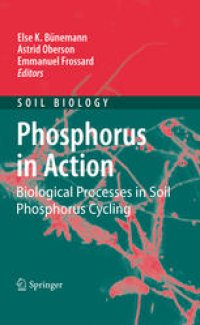
Ebook: Phosphorus in Action: Biological Processes in Soil Phosphorus Cycling
Author: Ashlea L. Doolette Ronald J. Smernik (auth.) Else Bünemann Astrid Oberson Emmanuel Frossard (eds.)
- Genre: Technique // Oil and Gas Technologies
- Tags: Biochemistry general, Plant Physiology, Microbiology, Agriculture, Soil Science & Conservation
- Series: Soil Biology 26
- Year: 2011
- Publisher: Springer-Verlag Berlin Heidelberg
- Edition: 1
- Language: English
- pdf
Phosphorus (P) is a finite resource which is essential for life. It is a limiting nutrient in many ecosystems but also a pollutant which can affect biodiversity in terrestrial ecosystems and change the ecology of water bodies. This book collects the existing, up-to-date information on biological processes in soil P cycling, which to date have remained much less understood than physico-chemical processes. The methods section presents spectroscopic techniques, characterization of microbial P forms, as well as the use of tracers, molecular approaches and modeling of soil-plant systems. The section on processes deals with mycorrhizal symbioses, microbial P solubilization, soil macrofauna, phosphatase enzymes and rhizosphere processes. On the system level, P cycling is examined for grasslands, arctic and alpine soils, forest plantations, tropical forests, and dryland regions, while aspects of P management with respect to animal production and cropping are also presented. The final chapter examines the interactions between global change and P cycling.
Phosphorus (P) is a finite resource which is essential for life. It is a limiting nutrient in many ecosystems but also a pollutant which can affect biodiversity in terrestrial ecosystems and change the ecology of water bodies. This book collects the latest information on biological processes in soil P cycling, which to date have remained much less understood than physico-chemical processes. The methods section presents spectroscopic techniques and the characterization of microbial P forms, as well as the use of tracers, molecular approaches and modeling of soil-plant systems. The section on processes deals with mycorrhizal symbioses, microbial P solubilization, soil macrofauna, phosphatase enzymes and rhizosphere processes. On the system level, P cycling is examined for grasslands, arctic and alpine soils, forest plantations, tropical forests, and dryland regions. Further, P management with respect to animal production and cropping, and the interactions between global change and P cycling, are treated.